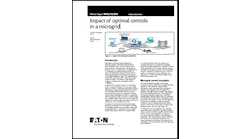The microgrid market is growing — at different paces in different segments — but the industry needs to educate others about its benefits, according to leading industry members.
“I would consider the current microgrid market to be highly diverse. There are opportunities to be involved in utility, building, campus, government, and industrial microgrids. Each type is at a different place in its respective market maturity,” said Doug Jones, business unit director, SCADA and analytic services, Power Engineers.
The utility market is the least mature, although a few, small and groundbreaking projects are making a splash, he said.
“The utility microgrid is unique in that it seeks to sell power via the microgrid while accomplishing other objectives such as renewable integration, resiliency, scalability, etc.,” Jones added.
The more mature markets are farther along because they face fewer regulatory obstacles. These include non-utility projects that use power produced by microgrids onsite, according to Jones.
Tony Locker, vice president, new product development and strategy at G&W Electric, also sees the market growing — and quickly. Revenues are expected to triple between 2017 and 2024 in response to customers’ requests, technology advances, new business models and, in part, regulations, he said.
“Customers are asking for cleaner and more reliable power; technological advancements have lowered the price-point for DERs [distributed energy resources] and eased interoperability,” he said. And new business models and regulations are allowing utilities, municipalities, universities, military bases, and other users to consider microgrids’ benefits, he said. Those advantages include increased reliability, lower and cleaner generation costs, and stable energy costs, he said.
Michelle Blaise, senior vice president of technical services for Commonwealth Edison (ComEd), said the market is increasing in response to a recognition of the environmental, operational, and resiliency benefits of microgrids.
“It’s becoming increasingly clear to regulators, stakeholders and utilities that microgrids represent an important building block of the grid of the future, and the market is responding to this reality,” she said.
“It’s becoming increasingly clear to regulators, stakeholders and utilities that microgrids represent an important building block of the grid of the future…” Michelle Blaise, ComEd.
Challenges within the microgrid market
Challenges impeding the market include the difficulty of placing a monetary value on resiliency; high costs; and difficulty getting costs approved by regulators for inclusion in utility rate base, said the industry members. They also pointed to technology challenges in certain applications.
“One primary challenge is determining where and when it makes the most sense to install microgrids,” said ComEd’s Blaise. “Because it can be difficult to place a monetary value on resilience before the need for it arrives, some are more cautious about particular projects, even if they recognize the value provided by this technology.”
Jones said that major challenges are cost and return on investment. That makes it hard for regulators to approve of proposals to include utility microgrid costs in rate bases.
However, for non-utility microgrids, the capital and engineering costs need to be weighed against the benefits of resiliency, the ability to leverage renewable energy and flexibility, he said.
Variability in regulation at the state level also impedes progress, said Jones. More standardized regulations will give the market more flexibility, he said.
Jones expects the costs of renewable energy and storage assets to continue to drop. In addition, costs will fall as microgrid master controllers develop, enabling microgrid owners to take advantage of the financial benefits of their investments.
In the meantime, the industry needs to educate people about the benefits of microgrids in order to move the market forward, said the industry members.
Lessons the Bronzeville microgrid will offer
ComEd is now developing a comprehensive list of the benefits and is working on a cost-benefit analysis for its demonstration Bronzeville Microgrid Project, Blaise said.
The Bronzeville demonstration project will provide information about how to use microgrids to increase the penetration of renewable distributed generation.
The master microgrid controller can make distributed generation deployment more efficient, Blaise said.
The US Department of Energy awarded ComEd a $4 million grant to install solar PV and energy storage in the microgrid. The project will help people learn not only about microgrids but about how the entire distribution system will evolve as more distributed energy resources are connected, she said.
“This effort needs buy-in, collaboration and support from regulators, stakeholders, and our fellow stakeholders across the country,” she said.
Locker agreed that educating possible users about the benefits of microgrids is key.
“The building blocks are in place with hundreds of successful installations. As more potential users become knowledgeable on the benefits and what is required to implement, the adoption curve will only continue to significantly increase,” he said.
Microgrid owners should share best practices about both business strategies and technology developments, he said.
Said Blaise, “The time has come for the industry to promote the value for the resiliency benefits provided by microgrids to ensure that customers, regulators, stakeholders, community leaders, and our society understand the important benefits to help develop clear pathways to future projects.”
Join us May 7-9 at Microgrid 2018 to continue the discussion about what’s spurring and what’s impeding the microgrid market.







